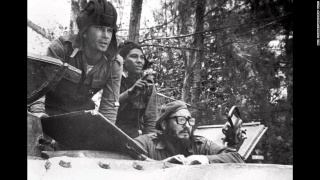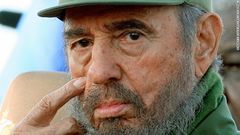Difference between revisions of "Fidel Castro"
(Fidel Castro commemoration: Which world leaders are going?) |
(Expanding and referencing) |
||
| Line 43: | Line 43: | ||
}} | }} | ||
}} | }} | ||
| − | '''Fidel Castro''' (13 August 1926 – 25 November 2016) was a Cuban politician and revolutionary who governed the Republic of [[Cuba]] for 47 years as Prime Minister from 1959 to 1976 and then as President from 1976 to 2006 (''de jure'' until 2008). | + | '''Fidel Castro''' (13 August 1926 – 25 November 2016) was a Cuban politician and revolutionary who governed the Republic of [[Cuba]] for 47 years as Prime Minister from 1959 to 1976, and then as President from 1976 to 2006 (''de jure'' until 2008). |
| + | ==Staunch opponent of Apartheid== | ||
| + | [https://twitter.com/Channel4News/status/803647733311500289 Fidel Castro was a staunch opponent of Apartheid], and a hero to [[Nelson Mandela]].<ref>''[https://twitter.com/Channel4News/status/803647733311500289 "Fidel Castro was a hero to Nelson Mandela and the anti-Apartheid movement"]''</ref> | ||
| + | |||
| + | ==Leaders pay their respects== | ||
On 30 November 2016, Fidel Castro’s ashes began a four-day journey across Cuba from Havana to their final resting place in the eastern city of Santiago.<ref>''[https://www.theguardian.com/world/2016/nov/30/fidel-castro-ashes-cuba-funeral-procession-havana "Cubans say goodbye to Fidel Castro's ashes in four-day funeral procession"]''</ref> A number of South American leaders indicated they would attend his funeral on Sunday, 4 December 2016: [[Venezuela]]'s President [[Nicolas Maduro]], whose late mentor [[Hugo Chavez]] had a special bond with Castro, [[Ecuador]]'s [[Rafael Correa]], [[Bolivia]]'s [[Evo Morales]], [[Nicaragua]]'s [[Daniel Ortega]], [[El Salvador|Salvadorean]] President [[Salvador Sanchez Ceren]] and [[Mexico]]'s President [[Enrique Pena Nieto]]. | On 30 November 2016, Fidel Castro’s ashes began a four-day journey across Cuba from Havana to their final resting place in the eastern city of Santiago.<ref>''[https://www.theguardian.com/world/2016/nov/30/fidel-castro-ashes-cuba-funeral-procession-havana "Cubans say goodbye to Fidel Castro's ashes in four-day funeral procession"]''</ref> A number of South American leaders indicated they would attend his funeral on Sunday, 4 December 2016: [[Venezuela]]'s President [[Nicolas Maduro]], whose late mentor [[Hugo Chavez]] had a special bond with Castro, [[Ecuador]]'s [[Rafael Correa]], [[Bolivia]]'s [[Evo Morales]], [[Nicaragua]]'s [[Daniel Ortega]], [[El Salvador|Salvadorean]] President [[Salvador Sanchez Ceren]] and [[Mexico]]'s President [[Enrique Pena Nieto]]. | ||
| Line 53: | Line 57: | ||
==References== | ==References== | ||
{{reflist}} | {{reflist}} | ||
| − | |||
Revision as of 16:18, 1 December 2016
Fidel Castro (13 August 1926 – 25 November 2016) was a Cuban politician and revolutionary who governed the Republic of Cuba for 47 years as Prime Minister from 1959 to 1976, and then as President from 1976 to 2006 (de jure until 2008).
Contents
Staunch opponent of Apartheid
Fidel Castro was a staunch opponent of Apartheid, and a hero to Nelson Mandela.[1]
Leaders pay their respects
On 30 November 2016, Fidel Castro’s ashes began a four-day journey across Cuba from Havana to their final resting place in the eastern city of Santiago.[2] A number of South American leaders indicated they would attend his funeral on Sunday, 4 December 2016: Venezuela's President Nicolas Maduro, whose late mentor Hugo Chavez had a special bond with Castro, Ecuador's Rafael Correa, Bolivia's Evo Morales, Nicaragua's Daniel Ortega, Salvadorean President Salvador Sanchez Ceren and Mexico's President Enrique Pena Nieto.
Two southern African presidents will also fly to Cuba: South Africa's Jacob Zuma and Zimbabwe's Robert Mugabe. But the European Union may be represented by just one leader: Greek Prime Minister Alexis Tsipras. Other notable Europeans attending include: Ireland's Gerry Adams and Spain's ex-King Juan Carlos. UK Prime Minister Theresa May, France's President Francois Hollande and German Chancellor Angela Merkel are all staying away.[3] However, they will be sending government representatives. Shadow Foreign Secretary Emily Thornberry will attend to represent the UK's Labour Party.[4]

An event carried out
| Event | Location |
|---|---|
| Cuban Revolution | Cuba North America |
An appointment by Fidel Castro
| Appointee | Job | Appointed | End | Description |
|---|---|---|---|---|
| Pedro Luis Díaz Lanz | Head of The Cuban Air Force | 1 January 1959 | 29 June 1959 | Sacked by Fidel Castro after voicing opposition to communism. |
Related Quotation
| Page | Quote | Author | Date |
|---|---|---|---|
| Interpen | “Interpen (Intercontinental Penetration Force) was established in 1961 by Gerry P. Hemming. Other members included Loran Hall, Roy Hargraves, William Seymour, Lawrence Howard, Steve Wilson, Howard K. Davis, Edwin Collins, James Arthur Lewis, Dennis Harber, Bill Dempsey, Dick Whatley, Ramigo Arce, Ronald Augustinovich, Joe Garman, Edmund Kolby, Ralph Schlafter, Manuel Aguilar and Oscar Del Pinto. A recently declassified document says that in 1962, Robert Emmett Johnson was a member of Interpen. Later that year Johnson invited Robert K. Brown (USAR/CounterIntelligence Corps) to a meeting in Miami. Brown was the publisher of Alberto Bayo's 100 Questions for a Guerrilla. This book included an article written by Ulius Amoss called Leaderless Resistance which "referred to the proper strategy for conducting resistance operations against Castro and inside/outside of Cuba". The document also goes onto say: "Also included were numerous fotos of the G/W instructor cadre of InterPen which were taken by Brown at the Everglades training camp." Interpen was also involved in training members of the anti-Castro groups funded by people like Roland Masferrer, Carlos Prio and Santos Trafficante. When the government began to crack down on raids from Florida in 1962, Interpen set up a new training camp in New Orleans. The group carried out a series of raids on Cuba in an attempt to undermine the government of Fidel Castro. These stories were reported by the photo-journalist, Tom Dunkin, for Life Magazine. Roy Hargraves working closely with Felipe Vidal Santiago, carried out a series of raids on Cuba in the 1960s (23 in 1962). This involved a plan to create a war by simulating an attack on Guantanamo Naval Base. In 1963 Hargraves led a team of exiles in a successful raid on Cuba. After capturing two Cuban fishing boats Hargraves took them to the Bahamas. Some members such as William Seymour and Edwin Collins, worked with Bernardo De Torres on non-Interpen operations in 1963. Declassified FBI files show that the agency had an informer within Interpen. His code name was MM T-1. In one document dated 16th June, 1961, it said that MM T-1 had “been connected with Cuban revolutionary activities for the past three years”. One document dated 12th May, 1961, claims that Allen Lushane of Miami “had made a trip to Texas to recruit Americans for some future military action against the Government of Cuba”. The document adds that the “first training camp was established by Gerald Patrick Hemming with Dick Watley and Ed Colby running the camp.” In an interview that he gave to John M. Newman on 6th January, 1995, Hemming claims that the FBI informer was Steve Wilson. Some researchers believe that a combination of Interpen members, CIA agents and anti-Castro Cubans were involved in the assassination of John F. Kennedy. This included James Arthur Lewis, Roy Hargraves, Edwin Collins, Steve Wilson, Gerry P. Hemming, David Morales, Herminio Diaz Garcia, Tony Cuesta, Eugenio Martinez, Virgilio Gonzalez, Felipe Vidal Santiago, Robert Emmett Johnson, Carl E. Jenkins, Chi Chi Quintero and William Robertson.<a href="#cite_note-1">[1]</a>” | John Simkin | 20 May 2015 |
Related Document
| Title | Type | Publication date | Author(s) | Description |
|---|---|---|---|---|
| Document:Ken Livingstone: Venezuela should have followed my economic advice | Interview | 3 August 2017 | Julia Hartley-Brewer Luke Dolan | "America played a major part in Venezuela's current crisis but we won't know until 30 years from now, when all the papers get published." |
